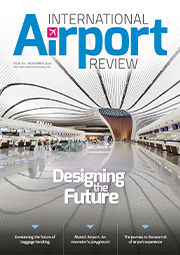Everyone’s talking about how to enhance non-aeronautical revenue
- Like
- Digg
- Del
- Tumblr
- VKontakte
- Buffer
- Love This
- Odnoklassniki
- Meneame
- Blogger
- Amazon
- Yahoo Mail
- Gmail
- AOL
- Newsvine
- HackerNews
- Evernote
- MySpace
- Mail.ru
- Viadeo
- Line
- Comments
- Yummly
- SMS
- Viber
- Telegram
- Subscribe
- Skype
- Facebook Messenger
- Kakao
- LiveJournal
- Yammer
- Edgar
- Fintel
- Mix
- Instapaper
- Copy Link
Posted: 20 June 2019 | Aude Ferrand - Groupe ADP, Dimitri Coll | Head ASQ | ACI World, Joseph Huber - CVG, Patrick Lucas - ACI, Tanja Dik - Amsterdam Airport Schipol, Tomasz Lenart - Wroclaw Airport | No comments yet
Non-aeronautical revenues are essential to airports’ financial health, so we asked industry experts how they ensure they reap the benefits of airport incomes.


In International Airport Review’s first-ever column, we spoke to some leading industry experts who told us how they focus on increasing non-aeronautical revenues.
Participants:
  |   |   |   |   |   |
| Patrick Lucas, Head of Airport Business Analytics, ACI | Dimitri Coll, Director of ACI’s ASQ programme | Tomasz Lenart, Passenger Services Manager, Wroclaw Airport | Aude Ferrand, Chief Retail Officer, Groupe ADP | Joseph Huber, Director Contract & Procurement Administration, CVG | Tanja Dik, Director of Consumer Products & Services, Amsterdam Airport Schiphol |
Patrick Lucas and Dimitri Coll: The rise in the number of global travellers alongside the increased use of mobile and digital technology, more competition and new e-commerce options has illustrated the crucial importance for non-aeronautical revenue for airports.
With technology at their fingertips, today’s passengers are seeking a seamless, secure and efficient journey that is highly personalised.
Retail facilities and food and beverage outlets represent, on average, more than one third of commercial revenue. However, disruptive technologies such as online retail and e-commerce platforms, and increased competition off-airport, has limited the growth prospects regarding airports’ non-aeronautical revenues.
Based on ACI’s Airport Economics Survey, non-aeronautical revenue share, which was estimated at 43.1 per cent in 2005, was recorded at 39.9 per cent in 2017.
The modern airport operator is a complex business, recognising the value of harnessing data to grasp the tastes and preferences of passengers to deliver a return on customer experience.
ACI’s ASQ programme provides a key source for this data as it is the globally established benchmarking programme measuring passenger satisfaction whilst travelling through an airport and provides a detailed view of the passenger experience.
It is crucial that airport operators use this data to attract the right blend of retailers and concessions by not only crafting a concession agreement to maximise net revenues from commercial activities but working closely with these concessions to achieve the ultimate goal of maximising overall customer experience.
The best way of increasing non-aeronautical revenues is to increase the customer satisfaction
Indeed, an increase of one per cent in the global passenger satisfaction mean, as defined by the ASQ Survey, generates on average a 1.5 per cent growth in non-aeronautical revenue.
Tomasz Lenart: I strongly believe the best way to improve non-aeronautical revenue is to focus on passenger experience.
To achieve this at Wroclaw Airport we focus on data collection, measurement and analysis in our own self-learning airport IT system, meaning we know who our passenger is and can predict their behaviour. We want to be one step ahead of both expectations and any problems that may occur during daily airport operations. We found that by sharing this information with all parties involved in airport processes, it became a revolutionary factor in daily passenger service – we adapted our systems to be available on their mobile devices. As a result, we beat the queues in areas that cause negative emotions (check-in, security control, immigration and baggage claim).
Passengers saved time and began to be more satisfied, which led to more time and money spent in the commercial areas of Wroclaw Airport
Alongside this is real-time information. We publish all flight details not only on screens in the terminal but on a chatbot application via Facebook Messenger. Once passengers have real-time information they feel safe and can plan their time more efficiently in available commercial areas before departure or after arrival.
By giving our passengers time, we witnessed a 10 per cent increase in non–aeronautical revenue above 20 per cent of passenger traffic growth last year.
Aude Ferrand: Groupe ADP claims a positioning around the ‘ultimate Parisian shopping and dining experience’ which is based on a strategy to drive a sustainable growth for revenues from shops, bars and restaurants. Our ambition is to be the only place in Paris with excellence across four drivers: Interior design and space management; brand portfolio; quality of service; and price positioning.
After the infrastructure projects are delivered we aim to achieve revenues per departing passenger of €25. 50
Therefore, we are focused on standardising the 58,000 square metres of commercial space before 2021, by terminal staging, refurbishment or creation of new retail and food and beverage spaces. Regarding the brand’s portfolio we developed the right balance between French and international brands, with an emphasis on French art of living, fragrances and cosmetics, luxury fashion and wines, which are attractive for a lot of international tourists. In Paris Airport, food and beverage has been strongly developed with many French bakeries and a restaurant managed by a Michelin-starred chef.
To be able to maintain our sustainable strategy on a long-term period we have built a robust business model with four joint ventures: Core and fashion, advertising, convenience, and food and beverage.
Last but not least, to stimulate the demand of frequent flyers and international customers, we have passenger-centric schemes in place, such as our loyalty programme and tailored services for VIPs.
Joseph Huber: Disruptors are only disruptive when airports are reactive. What if airports sought innovations and helped develop them to improve the airport while improving the bottom line?
CVG engages start-ups, partners with local universities and incubators, and attends demonstrations. After finding a fit, next is determining the relationship. Innovations can generate revenue through improved customer experience and CVG looks to monetise the innovation directly, which generally falls into one of three categories (and one hybrid):
- An innovation is available and CVG purchases it following standard processes
- An innovation is available but not focused on airports – the innovator agrees not to market the airport innovation to CVG’s competitors and CVG may receive the innovation at no charge or the best price
- CVG may negotiate a revenuesharing arrangement based on the intellectual property (IP) CVG contributes (the hybrid)
- CVG identifies a need and engages industry to develop the innovation. CVG retains all IP rights and generates revenue when the developer or third‑party licensee sells it.
A government entity may be restricted from directly investing or selling these innovations, and procurement regulations based on the cost and type of service must be considered.
Innovations do not have to be disruptive.
Through engagement, airports can embrace innovation to improve the airport and generate much needed non-aeronautical revenue
Tanja Dik: The world is changing faster than ever before, and travellers’ expectations have shifted. Our aim is to guide, relieve and excite travellers and make their time valuable at each of the 360 customer-journey touchpoints.
It all starts with understanding our customers’ desires through the entire travel and shopping journey
Current traveller needs, as well as the generation of travellers to come, drive the way we think, operate and innovate. It involves trends such as the growing importance of information transparency and accessibility, personalisation, ‘experience over assets’, sense of place, a mix of tailored propositions and offers, as well as sustainability as a ‘hygiene factor’.
We see that travel retail has become much more than shopping at the airport, but rather part of people’s everyday lives. That means global visibility is very important. Partner collaboration is key in order to innovate and offer the right value propositions. We strongly believe that integrated solutions and co-creation are the best way to realise the correct value propositions.
Our partnership with WeChat is one example. WeChat is a multifunctional app which offers features such as chat, social media and WeChat Pay, a mobile payment option. As WeChat Pay’s first flagship smart airport in Europe we are able to provide Chinese travellers with seamless travel services and a tailor-made shopping experience.
Using the app they can, for example, browse the range of virtually all of Schiphol’s retail outlets and place an order. The products will be readied by the retail outlets, and can be collected by the traveller before they depart. Passengers can also find specific information about their trip, such as flight information, and utilise 24/7 customer service.
The rest of this column is restricted - login or subscribe free to access


Why subscribe? Join our growing community of thousands of industry professionals and gain access to:
- bi-monthly issues in print and/or digital format
- case studies, whitepapers, webinars and industry-leading content
- breaking news and features
- our extensive online archive of thousands of articles and years of past issues
- ...And it's all free!
Click here to Subscribe today Login here
Issue
Related topics
Airport construction and design, Airside operations, Information technology (IT), Non-aeronautical revenue, Passenger experience and seamless travel, Retail, Terminal operations
Related airports
Amsterdam Airport Schiphol (AMS), Cincinnati/Northern Kentucky International Airport (CVG), Wroclaw Airport
Related organisations
Related people
Aude Ferrand, Dimitri Coll, Joseph Huber, Patrick Lucas, Tanja Dik, Tomasz Lenart


















